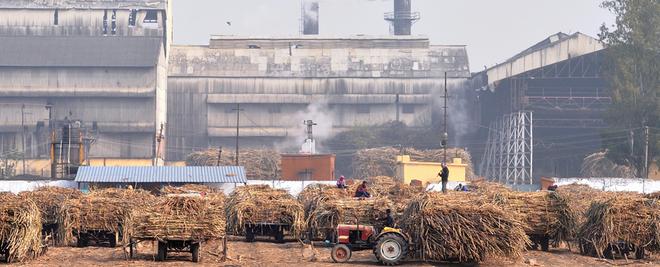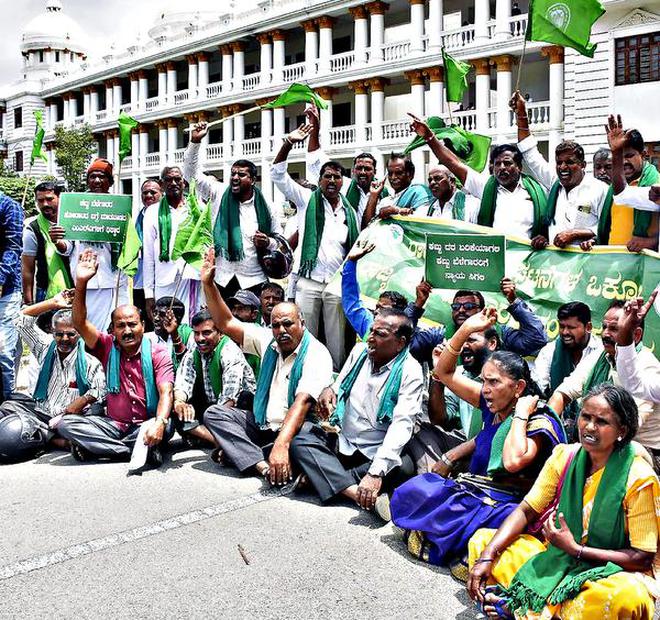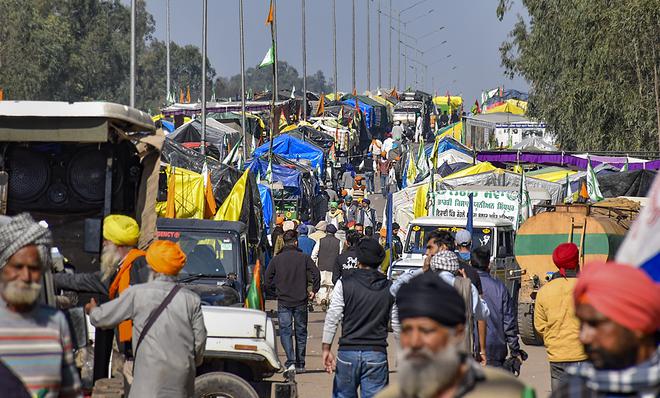The story so far: As farmers protest on Delhi borders, the Cabinet Committee on Economic Affairs on Wednesday approved ₹340/quintal as the Fair and Remunerative Price (FRP) of sugarcane for sugar season 2024-25 at 10.25% sugar recovery rate. Affirming its ‘guarantee’ to double farmers’ income, the Centre pointed out that the new FRP was 8% higher than that offered in the current season 2023-24. The new FRP will kick in from October 1, 2024, announced Union Information and Broadcasting Minister Anurag Thakur at a press briefing on February 21.
Hailing his Cabinet’s decision, Prime Minister Narendra Modi said the increase in sugarcane purchase price would benefit crores of farmers.
In a press release, the Centre informed that the new FRP was 107% higher than the A2+FL cost of sugarcane, benefiting over 5 crore sugarcane farmer families and lakhs of others operating in the sugar sector. A2+FL cost is the actual cost incurred by the farmer on seeds, fertilizers, chemicals, hired labour, and the family labour (FL) working on the farm.
Elaborating on the decision, Centre stated that with each 0.1% increase in recovery, farmers will get additional price of ₹3.32/quintal while the same amount will be deducted on reduction of recovery by 0.1%. With the minimum price being fixed at ₹315.10/quintal at 9.5% sugar recovery, farmers are assured of FRP at ₹ 315.10/quintal. Sugar recovery refers in percentage terms to the amount of sugar obtained from a certain amount of sugarcane after processing.
“It is noteworthy that India is already paying the highest price of sugarcane in the world and despite that Government is ensuring the world’s cheapest sugar to domestic consumers of Bharat,” read the release. It also stated that due to Modi government’s timely policy interventions, sugar mills have become self-sustainable and have not needed any financial assistance since 2021-22.
What is Fair and Remunerative Price (FRP)?
Fair and Remunerative Price (FRP) is the minimum price sugar mills have to pay farmers for sugarcane. In 2009, amending the Sugarcane (Control) Order, 1966, the Centre replaced the Statutory Minimum Price (SMP) of sugarcane with the Fair and Remunerative Price (FRP). Various factors like cost of production of sugarcane, recovery of sugar from sugarcane, price at which sugar is sold, profit from sale of sugar by-products like molasses, bagasse and press mud, margin for sugarcane growers, return to sugarcane growers from alternative crops, are considered in the FRP.
The price is decided by the Centre based on recommendations of the Commission for Agricultural Costs and Prices (CACP) and in consultation with State governments and sugar industry. However, some States like Uttar Pradesh, Haryana and Punjab offer higher prices for sugarcane under State Advised Price (SAP), which mills in those States must abide by.
How does is affect Minimum Selling Price (MSP)?
Not to be confused with Minimum Support Price for which farmers are currently marching to Delhi, the Minimum Selling Price for sugar was introduced by the Centre under the Sugar Price (Control) Order, 2018.
While Minimum Support Price is the minimum price at which governments procure crops (cereals, pulses, oilseeds, cotton, jute and coconut) from farmers, the Minimum selling price (MSP) is the minimum price at which sugar mills can sell sugar to the market. The MSP was introduced by the Centre to ensure that the industry gets at least the minimum cost of production of sugar, allowing them to clear sugarcane dues of farmers. MSP is determined taking FRP and and adding minimum conversion cost incurred by sugar mills running at highest efficiency. While the Centre has repeatedly hiked the FRP from ₹255/quintal of sugarcane in 2017-18 to ₹340/quintal, it has not changed MSP from ₹3100/quintal of sugar fixed in 2018-19.

Farmers have often complained of not receiving sugarcane dues from mills. However, mills claim that the MSP being stagnant despite food inflation has exposed the industry to ‘cash losses’, raising challenges to paying FRP to farmers. Seeking Prime Minister Modi’s intervention, the National Federation of Cooperative Sugar Factories (NFCFS) which heads all cooperative sugar mills, and the Indian Sugar Mills Association (ISMA) which leads private mills, urged him to hike MSP to ₹39.7/kg depending on quality.
Explained | Will a hike in MSP help farmers?
An FRP of ₹305/quintal for sugarcane at a recovery of 10.25%, amounts to ₹2,975.76 per quintal of sugar price, which is 96% of the MSP at Rs 3100/quintal. In its letter to the PM, the sugar mill bodies wrote, “If raw material costs itself constitutes 96% share of the present MSP, it is next to impossible to manage the conversion cost of sugar and related financial costs within a 4% window”. Mills claim that whenever raw materials estimate went beyond 80%, the industry faced losses and turned to government for financial bail out.
In response, the Food secretary Sanjeev Chopra told Financial Express that the Centre will consider the demand for higher MSP in sync with the FRP paid to farmers. ISMA claims that the Commission for Agricultural Costs and Prices may recommend hiking sugar MSP from Rs 3100/quintal to Rs 3900/quintal.
States, farmers and FRP
Farmers have often taken to the streets seeking higher FRP for sugarcane. With agriculture being both a State and Central subject in the Concurrent List of the Constitution, State governments facing the ire of farmers have often fixed procurement prices above the the FRP fixed by the Centre. This State Advised Price (SAP) burdens state-owned or private sugar mills with paying higher prices for sugarcane while keeping MSP at ₹31/kg (₹3,100/quintal) for domestic sugar consumers.
Asserting States’ say in fixing sugarcane prices, a five-judge Constitutional Bench of the Supreme Court on April 22, 2020, held that both the Central and State governments have such power. However, the Bench said that while a State cannot fix a “minimum price” if the Centre has already fixed it, the State is always welcome to fix the “advised price”.
“So long the State Advised Price shall always be higher than the minimum price fixed by the Centre, it cannot be said to be void,” ruled the Bench, adding that in case the advised price is lower, the price fixed by the Centre will prevail.
The States were further strengthened by the May 2023 Madras High Court judgement which said that the FRP fixed by the Centre was in reality not the fair market price at all, and that small and marginal farmers can survive only if State governments mandated a much higher ‘advised price’. The two rulings have provided relief to farmers who are seeking dues from sugar mills.

During the 2023-24 cane cutting season, farmers had agitated in major sugar producing States like Maharashtra, Punjab, Karnataka, Uttar Pradesh saying that the FRP fixed by the Centre did not even cover cultivation costs.
Maharashtra, the largest sugarcane cultivator, was hit by mass protests by farmers’ organisation Swabhimani Shetkari Sanghatana (SSS), which demanded an additional Rs 40 per quintal for the sugarcane crushed in the previous season and an FRP of Rs 350 per quintal for the 2023-24 season. However, the state government refused to intervene, only holding talks between the SSS and mill owners.
Tackling the issue at the national level, several sugarcane farmers have joined the farm unions’ ‘Chalo Dilli’ call, seeking higher FRP. Farmers from Karnataka State Sugarcane Cultivators Association have joined the protests headed by Samyukta Kisan Morcha seeking FRP to be hiked to ₹400 per quintal. Similarly, sugarcane farmers from Uttar Pradesh, Punjab and Haryana have joined the Delhi protests, seeking clearance of dues from state-owned sugar mills.
How will the FRP hike affect farmers’ protest?
The farmer unions marching towards Delhi mainly hail from Punjab, Haryana and Uttar Pradesh. The Centre’s decision to hike the sugarcane FRP has been termed as a ‘political move’ targeting two of the largest States, Maharashtra and Uttar Pradesh amounting to 80 and 48 Lok Sabha seats respectively, than a realistic one. Currently, Punjab has has an SAP of ₹391/quintal for sugarcane for the October season, while Uttar Pradesh offers ₹370/quintal and Haryana offers ₹386/quintal. All these State Advised Prices are higher than the FRP offered by the Centre of ₹340/quintal at 10.25% recovery.

Moreover, the bigger issue for which sugarcane farmers are protesting is clearance of dues to the tune of crores of rupees by state-owned sugar mills. Several sugar mills have been shut down due to increased fuel costs, lack of funds, losses due to low MSP and crushing debts. The meagre 8% hike in sugarcane FRP is unlikely to dent the protests as the major issues still remain unsolved.







